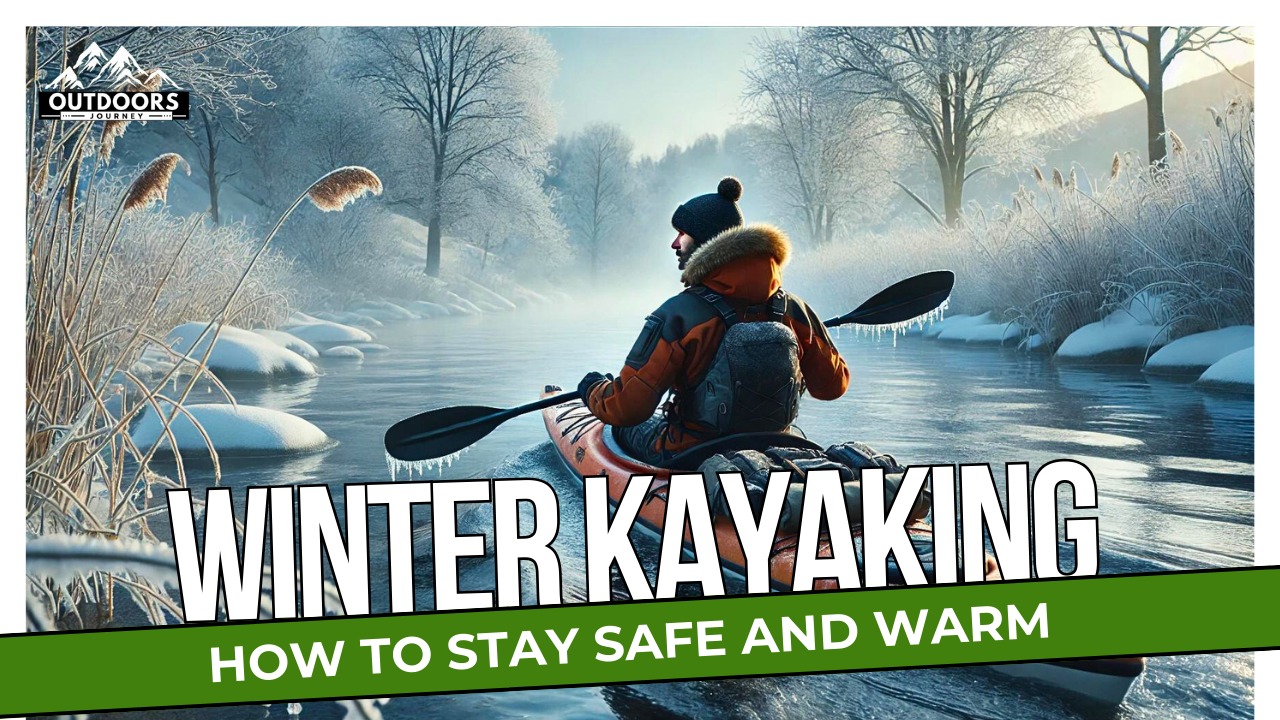Did you know that 84.5% of people who drowned in boating accidents weren’t wearing life jackets? This fact shows how crucial safety is in winter kayaking. Paddling in cold water can be thrilling but comes with risks like cold shock and hypothermia. With the right gear and knowledge, you can enjoy winter’s beauty safely and warmly. This guide will teach you about the best gear, how to layer, and important safety tips for winter kayaking.
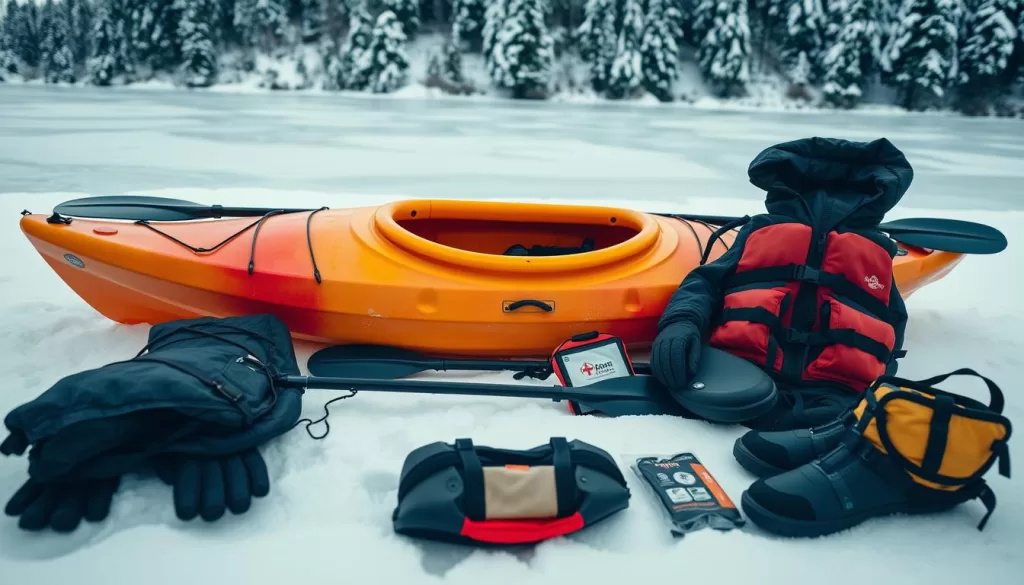
Key Takeaways
- Wearing a life jacket is crucial for safety during winter kayaking.
- Drysuits are mandatory for safe winter kayaking in cold conditions.
- Layering your clothing properly can keep you warm and dry.
- Assessing both air and water temperatures is essential for choosing the right gear.
- Having a friend along can enhance safety on your winter kayaking trips.
- Checking the weather forecast before heading out is vital to avoid sudden changes.
- 1 Introduction to Winter Kayaking
- 2 Understanding Cold Water Conditions
- 3 Essential Gear for Safe Winter Kayaking
- 4 Layering for Warmth During Winter Paddling
- 5 Keeping Your Extremities Warm
- 6 Winter Kayaking Safety Precautions
- 7 Winter Kayaking Techniques and Tips
- 8 Choosing the Right Location for Winter Kayaking
- 9 Winter Kayaking Trips and Tours
- 10 Winter Kayaking: How to Stay Safe and Warm
- 11 Emergency Preparedness for Cold Weather Paddling
- 12 Post-Paddling Care for Cold Weather Enthusiasts
- 13 Staying Informed: Resources for Winter Kayaking
- 14 Conclusion
- 15 FAQ
- 16 Source Links
Introduction to Winter Kayaking
Winter kayaking lets you see peaceful landscapes covered in frost, away from the summer crowds. It’s a rewarding activity that requires knowing how to stay safe in the cold. Planning your trip well is key to having fun and staying safe in the cold and icy waters.
Wearing the right clothes is crucial to stay warm. Make sure you have a hat, gloves, and wetsuit booties. A watertight kayak is also a must, with no cracks and all bolts tight to keep out the water. For extra warmth, use foam blocks or sheets where your skin touches the kayak.
Don’t forget a dry bag for your phone, keys, snacks, and extra clothes. Warming up before you start helps prevent injuries and keeps you comfortable. Pack snacks, hot drinks, and extra layers for your trip. Think about how long you’ll be out and adjust your plans accordingly.
Checking the weather before you go is very important. Look at the wind speed and river levels to make sure it’s safe. Remember, days get shorter in winter, so plan your trip to avoid paddling in the dark. Know the signs of cold water shock and hypothermia if you’re new to winter kayaking.
Winter offers unique experiences for kayakers, making it possible to paddle all year round. In places like the coast of Maine, the water is just above freezing. So, it’s important to be safe to avoid hypothermia if you fall into the water. Use VHF marine radios for emergencies. With these steps, you can have a safe and fun winter kayaking trip.
Understanding Cold Water Conditions
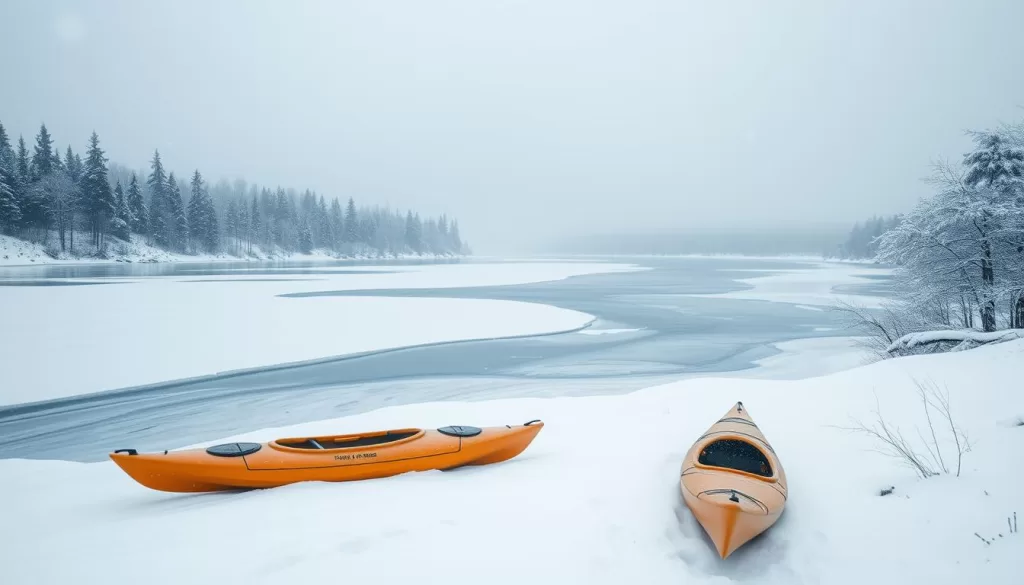
When planning your winter kayaking trip, knowing about cold water is key for safety. Cold water can cause shock, leading to serious reactions. Learning about air and water temperatures prepares you for a safer trip.
Recognizing Cold Water Shock
Cold water shock happens when your body suddenly gets cold, causing panic and gasping. This can make your heart race and breathing quicken. Knowing these signs helps you stay calm and avoid accidents.
Assessing Water and Air Temperatures
Check both air and water temperatures before you go. Water under 70°F can lead to hypothermia, and below 50°F is even more dangerous. Air temperature affects how fast you lose heat. Always look at the forecast and be ready for changes.
| Temperature Range | Risk Level | Recommended Actions |
|---|---|---|
| Above 70°F | Low Risk | Standard safety precautions |
| Above 60°F | Moderate Risk | Wear a wetsuit |
| 50°F – 60°F | High Risk | Use a drysuit, stay close to shore |
| Below 50°F | Very High Risk | Avoid boating unless experienced |
Be well-prepared and informed about cold water for a safe and fun kayaking trip this winter.
Essential Gear for Safe Winter Kayaking
Getting ready for kayaking in the cold means focusing on the right gear. Each item is key to keeping you safe and comfy. It helps make your winter kayaking trip enjoyable and safe.
Importance of a Life Jacket
A life jacket is a must-have for safety, especially in cold water. Inflatable PFDs rated for below 45 degrees are best. This is crucial in places like Ohio, where cold water can cause hypothermia fast. Always wear your life jacket while paddling to save your life in an emergency.
Choosing the Right Drysuit or Wetsuit
Choosing the right drysuit or wetsuit is vital for winter kayaking. A drysuit keeps you dry and warm. Look for ones with rubber gaskets at wrists, neck, and feet for extra cold protection. For wetsuits, the Neo-Sport Premium 5mm neoprene is a good choice. Both types help keep you warm in cold water.
Recommended Accessories for Cold Weather
Some accessories make winter kayaking safer and more comfortable. Waterproof gloves, a warm hat, and special shoes like NRS WTB wet shoes or Columbia Caldorado III trail runners keep you protected. A headlamp and signaling devices like a flashing beacon or air horn help in emergencies. Also, a spare collapsible paddle is a must for unexpected situations.
Layering for Warmth During Winter Paddling

Proper layering is key to staying warm and safe while paddling in winter. Each layer helps control your body temperature and shields you from the cold. Knowing how to layer right can greatly improve your experience in cold weather.
Base Layer: The Key to Staying Dry
The base layer is crucial for managing moisture. Choose high-quality materials like merino wool or synthetic fabrics. They keep sweat away and maintain warmth. Make sure it fits well to keep the warmth in.
Midlayer Tips: Insulating Options
Your mid-layer should add insulation. Consider fleece, synthetic puffy jackets, or thicker neoprene. These keep you warm without being too bulky. Pick materials that stay warm even when wet for the best performance.
Outer Layers: Protection Against Elements
A good outer layer protects you from wind and water. Waterproof and windproof jackets or dry suits work best. For serious winter paddlers, investing in quality gear like Gore-Tex drysuits is worth it. It helps keep your core temperature stable while on the water.
Keeping Your Extremities Warm
When you’re kayaking in the winter, it’s key to keep your hands, feet, and head warm. These parts of your body lose heat fast in the cold. The right gear can make a big difference in your comfort and safety.
Hand Protection: Gloves and Pogies
For warm hands while paddling, think about waterproof gloves or thick neoprene mittens. They keep the cold out and let you grip your paddle well. Pogies are another good choice, keeping your hands warm and easy to get in and out of.
Keeping Feet Dry with Suitable Booties
Warm and dry feet are a must for winter kayaking. Drysuits with built-in socks are great because they keep water out. If you like booties, choose ones that aren’t too tight with thick wool socks. This helps keep your feet warm and circulation good.
The NRS HydroSkin Wetsocks and Attack Shoes are great for staying warm and comfy.
Head Gear: Helmets and Balaclavas
Your head loses a lot of heat, so a balaclava or neoprene hood is crucial. They keep you warm and protect against cold winds, even with a waterproof helmet. A well-fitting helmet is key for safety, and with a balaclava, your head stays warm in icy waters.
| Gear Type | Recommended Options | Benefits |
|---|---|---|
| Hands | Thick neoprene mittens, NRS Maverick Gloves | Insulation and dexterity while paddling |
| Feet | NRS HydroSkin Wetsocks, NRS Attack Shoes | Dry and warm with proper circulation |
| Head | NRS Storm Hood, Balaclava | Heat retention and wind protection |
Winter Kayaking Safety Precautions
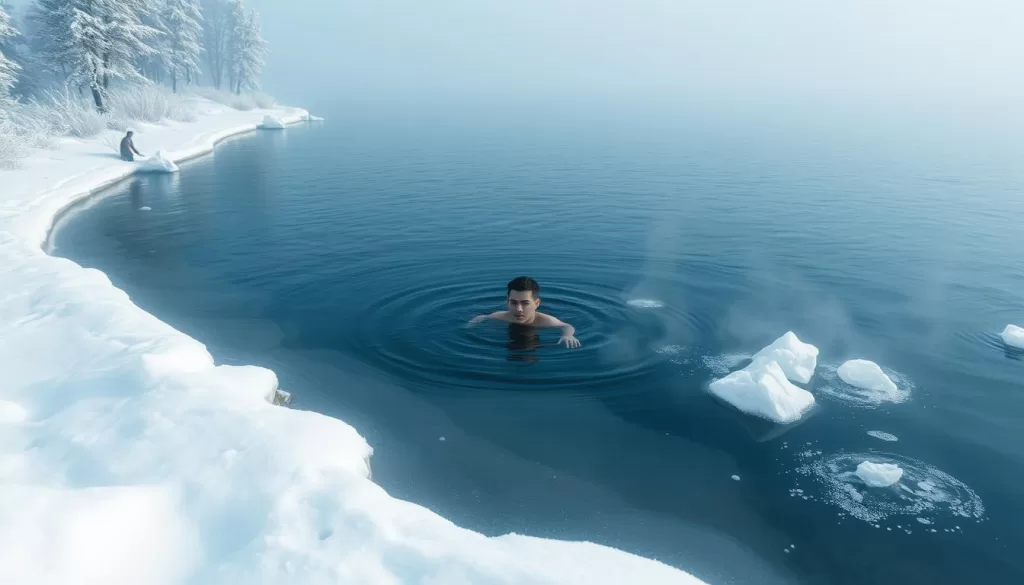
Winter kayaking needs awareness and prep to stay safe. Cold water immersion is a big risk. Knowing the dangers and having a float plan helps.
Understanding Cold Water Immersion Risks
Cold water can cause hypothermia and increase drowning risks. Use the right gear like drysuits and neoprene gloves. Paddling with experienced people can teach you important safety skills.
It’s safer to paddle with others. They can help quickly if you need it.
Creating a Float Plan Before Paddling
A float plan is key for safety. Tell friends or family your route and when you’ll be back. This way, someone knows where you are if something goes wrong.
Always bring safety gear like signaling devices. Taking cold weather workshops can make you more ready for winter kayaking. This way, you can enjoy your trips safely.
Winter Kayaking Techniques and Tips
When you go kayaking in the cold, you need to change how you do things. Winter kayaking brings its own set of challenges. Learning how to paddle in icy waters will make you safer and more fun on the water.
Optimizing Paddle Strokes in Cold Water
Your paddle strokes need to change in winter. Use shorter, more precise strokes for better control. This helps you stay balanced in icy waters. It also makes you more efficient and less tired.
Learning the right kayaking techniques helps you stay confident and strong. It keeps you going even in freezing temperatures.
Dealing with Icy Conditions
Be careful when dealing with ice on the water. Check your kayak and paddles for ice that could slow you down. Learn how to move around ice shelves and avoid hazards.
Being safe and ready is key for a good time kayaking in winter. It lets you enjoy the beauty of the season.
Choosing the Right Location for Winter Kayaking
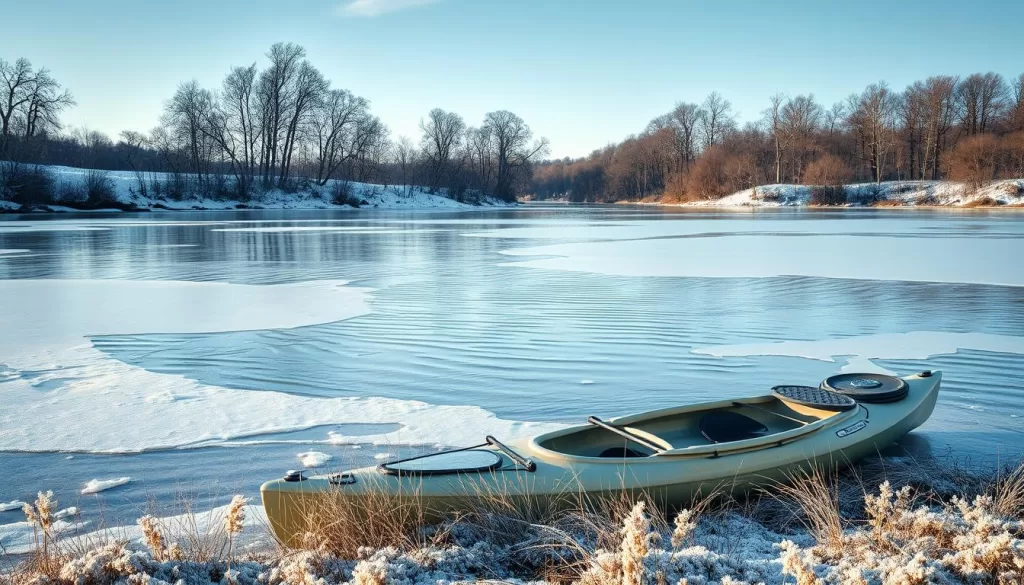
Choosing the right spot for winter kayaking is key to a good time and safety. Go for calm and flat lakes as they are easier to navigate. Coastal waters might look tempting but can turn dangerous fast. It’s important to know the differences in water bodies before you go.
Best Types of Water Bodies for Winter Paddling
Some places are better for winter kayaking because they are more stable:
- Lakes – They usually have calm waters, which means fewer risks from waves and currents.
- Rivers – Pick slow-moving rivers because they are easier to paddle. Fast rivers can be too risky.
- Coastal Areas – Be careful here. The weather can change fast, making it harder for winter kayaking.
Assessing Weather Forecasts
Always check the weather forecast before you go kayaking in winter. Look out for:
- Temperature – Cold water can be a big risk if it’s below 60 degrees Fahrenheit.
- Storm Predictions – Watch out for winter storms. Heavy snow can make it very dangerous.
- Wind Conditions – Strong winds can make it hard to control your kayak.
With a good weather forecast, you can plan better for winter kayaking. Think about how easy it is to get to your spot and make sure it’s safe and fun.
Winter Kayaking Trips and Tours
Winter kayaking trips are an exciting way to see nature’s beauty in the cold. For beginners, guided tours are a great way to start. They offer safety and teach important skills for winter paddling.
Finding Guided Winter Kayaking Tours
When looking for guided tours, choose reputable providers known for their winter kayaking. Consider these factors:
- Expertise of guides: Make sure they know how to handle winter conditions.
- Group sizes: Smaller groups are safer and allow for better focus.
- Equipment provided: Ensure they offer the right gear, like PFDs for cold water.
- Reviews and return rates: Look for tours with high customer satisfaction, like Pybus Point Lodge with a 65% return rate.
Guided tours stress the need to protect your eyes from the sun’s glare on the water. Always wear polarized sunglasses for eye safety during winter kayaking.
Planning Your Own Winter Kayaking Adventure
If you want to plan your own trip, think about your skills and how fit you are. Here are some key points to consider:
- Invite experienced paddlers: Having skilled friends can help with challenges.
- Assess weather conditions: Know the tides and currents, as high tides can make waves bigger.
- Prepare for temperature fluctuations: A good dry suit and extra warm layers are key to staying warm.
- Prioritize safety gear: Always carry devices like whistles to follow U.S. Coast Guard rules.
With careful planning, your winter kayaking trip can be unforgettable. Whether you join a guided tour or plan your own, it’s a chance to enjoy the peaceful beauty of winter on the water.
Winter Kayaking: How to Stay Safe and Warm

Winter kayaking calls for careful planning to stay safe and warm. The right gear is key for a good time, especially in the cold. Start with a thin Merino wool shirt next to your skin to keep moisture away. Then, add a long-sleeved lycra shirt and a reliable paddling jacket.
It’s important to stay hydrated to avoid getting too cold. Know your area and plan your route before you go. Staying near shore helps with safe returns and lowers risks.
Choosing the right clothes is vital. Wear wool hats, waterproof gloves, and thick hiking socks to keep your head, hands, and feet warm. Knowing how to get back into your kayak safely is crucial. Tell someone your plans and when you expect to return for extra safety.
Look for sheltered spots, like behind rocks or deep brush, for camping. Bring high-calorie snacks and easy meals to keep your energy up. Testing your camping setup beforehand helps you learn how to stay warm.
Safety should always come first. Always wear a personal flotation device (PFD). Most boating accident victims weren’t wearing life jackets, which is a big risk in winter. Learning to stay safe while kayaking in winter makes your trips enjoyable and memorable.
| Gear Type | Recommendation | Purpose |
|---|---|---|
| Drysuit | Kokatat, Immersion Research | Essential for warmth in cold water below fifty degrees |
| Base Layer | Merino wool or synthetic | Wicks moisture and retains heat |
| PFD (Life Jacket) | Any approved brand | Provides buoyancy and warmth |
| Footwear | Waterproof booties and thick socks | Keeps feet dry and warm |
| Head Gear | Wool hat | Insulates and retains heat |
| Gloves | Waterproof gloves | Keeps hands warm and dry |
Emergency Preparedness for Cold Weather Paddling
Being ready for emergencies during winter kayaking trips is key. Cold weather can make simple accidents serious if you’re not prepared. Having the right supplies and signaling devices helps you stay safe and respond quickly if something goes wrong.
Carrying a First-Aid Kit and Safety Gear
Always have a well-stocked first-aid kit in your kayak. This kit should have thermal blankets, adhesive bandages, and antiseptic wipes for cold-weather emergencies. Safety gear is also crucial, so consider including the following:
- Emergency blanket
- High-visibility signaling devices like whistles and flares
- A reliable radio for communication
Being prepared for minor injuries and possible scenarios like capsizing helps you handle unexpected challenges. Think about bringing practical items, like a drysuit or wetsuit, for protection from cold water.
Using Signaling Devices for Safety
If emergencies happen, it’s crucial to signal for help. Where you position yourself can greatly affect how fast help arrives. Effective devices include:
- Whistles, which can be heard over long distances
- Flares for day or nighttime visibility
- An emergency radio, enabling communication in remote areas
Practice using these devices and make sure they’re easy to reach. This is part of being well-prepared for emergencies and ensures a quick response if you’re in a cold water situation.
Post-Paddling Care for Cold Weather Enthusiasts

After a day of winter kayaking, taking care of yourself and your gear is key. Dealing with cold exposure is crucial. The right steps keep you safe and your gear in good shape.
De-Icing Your Gear After Paddling
It’s important to de-ice your gear after being in the cold. Ice on your gear can make your next trip harder. Use hand dryers or drying stations to thaw your equipment. Here’s what to do:
- Remove ice from your paddle and kayak.
- Dry neoprene boots and gloves to avoid damage from moisture.
- Keep your gear in a warm spot to stop it from freezing again.
Recovering from Cold Exposure
Getting warm after being in the cold is just as important as the kayaking itself. Warm up slowly to avoid shocking your body. Watch for signs of hypothermia and act fast if you notice:
- Shivering or feeling very tired.
- Confusion or hard-to-understand speech.
- Difficulty with your movements.
Warm drinks and extra clothes can help you warm up. Follow these steps for the best post-paddling care. This way, your adventures will stay fun and safe.
Staying Informed: Resources for Winter Kayaking
It’s key to keep up with the latest on winter kayaking gear, conditions, and best practices for a safe and fun trip. Reliable info can make your paddling adventure better. Joining winter paddling communities connects you with others who share valuable insights and experiences. These groups often talk about local conditions, safety tips, and new winter kayaking resources.
Finding Reliable Info on Gear and Conditions
When planning your winter kayaking trips, look for resources with the latest and most accurate info. Local paddling associations offer great gear advice and tips for your area. Online forums and social media groups are great for getting personal experiences and reviews from experienced paddlers.
Joining Winter Paddling Communities
Being part of winter paddling communities is rewarding and informative. These groups support each other and offer chances to learn and share. Joining in on organized paddling events or workshops gives you hands-on training on safety, techniques, and gear. This keeps you up-to-date with the latest in winter kayaking.
| Resource Type | Description | Benefits |
|---|---|---|
| Local Paddling Associations | Organizations that focus on kayaking events and education. | Access to expert knowledge and local conditions. |
| Online Forums | Discussion platforms where paddlers share experiences. | Real-time updates and personal tips. |
| Social Media Groups | Communities on platforms like Facebook or Instagram. | Networking and quick info exchange. |
| Safety Workshops | Events that focus on essential paddling safety knowledge. | Hands-on Training for emergency preparedness. |
Conclusion
Winter kayaking is thrilling and peaceful, but safety comes first. Make sure you have the right gear for the cold. A drysuit, insulated gloves, and a good personal flotation device are must-haves.
Staying warm is key to avoiding cold shock and hypothermia. These can be deadly in icy waters.
Knowing the environment is also crucial for a safe trip. Check the weather and water conditions before you go. Watch out for ice and have a plan for emergencies, like signaling devices and shore routes.
With the right layers and safety steps, you can enjoy winter kayaking fully. Embrace the quiet of the season while staying ready for any challenges. Proper planning and caution make winter kayaking safe and fun.
FAQ
What gear do I need for winter kayaking?
How can I stay warm while kayaking in cold weather?
What should I do if I fall into cold water?
How do I create a float plan for my kayaking trip?
What are the risks of paddling in cold weather?
Are there specific paddle techniques for winter kayaking?
What’s the best type of water to kayak in during winter?
Should I join a guided winter kayaking tour as a beginner?
How do I recover after a cold weather kayaking trip?
How can I stay informed about winter kayaking conditions?
Source Links
- Winter Kayaking: Best Gear & How to Layer – https://madelinemarquardt.com/winter-kayaking-best-gear-how-to-layer/
- Winter Kayaking Safety Precautions – https://www.inflatablekayakworld.com/winter-kayaking-safety-precautions/
- Winter Paddling | Top ten tips for paddling during the Winter months – https://gopaddling.info/top-10-tips-to-help-you-keep-paddling-through-winter/
- The Joys & Risks of Winter Sea Kayaking – https://www.portlandpaddle.net/the-joys-risks-of-winter-sea-kayaking/
- Paddling in Cold Weather: A Safety Guide | Haw River Canoe & Kayak – https://hawrivercanoe.com/paddling-in-cold-weather-a-safety-guide/
- Understanding the Perils of Cold Water Immersion When Kayaking: Safety Tips and Precautions – https://www.kayakcentre.com/blogs/blog/understanding-the-perils-of-cold-water-immersion-w/
- Cold water paddling safety tips | What to wear | Winter paddling – https://rescue.borealriver.com/paddling/cold-water-paddling/
- Safe Cold-Water Kayaking – https://paddling.com/learn/safe-cold-water-kayaking
- The Best Winter Kayak Clothing for Safety, Warmth and Comfort – https://betterboat.com/blogs/boating/winter-kayak-clothing
- Winter Paddling Safety – https://bendingbranches.com/blogs/resources/winter-paddling-safety
- The Guide to Winter Paddling Dressing – https://westerncanoekayak.com/blog/the-guide-to-winter-paddling-dressing/?srsltid=AfmBOopX-o60icfm3Ke-pIdPGafNj-TPkCB5cSx13SNeQ17_Ay68Qn1j
- Layering For Warm And Comfortable Winter Fishing – https://kayakanglermag.com/tactics-skills/layering-for-warm-winter-fishing/
- Dressing for Cold Weather Paddling – https://paddling.com/learn/dressing-for-cold-weather-paddling
- Hot Tips: How to Keep Warm Paddling in the Winter – https://www.kayaksession.com/hot-tips-how-to-keep-warm-paddling-in-the-winter/
- How to Stay Warm When Kayaking – https://www.nrs.com/learn/stay-warm-when-kayaking
- Winter Sea Kayaking – https://forums.paddling.com/t/winter-sea-kayaking/52416
- Tips for Paddling in the Winter – Watershed Drybags – https://www.drybags.com/tips-for-paddling-in-the-winter/
- Winter Kayaking – https://www.paddlinglight.com/articles/kayaks/winter-kayaking/
- Kayaking and Cold Water Immersion – Tsunami Rangers – https://tsunamirangers.com/2011/02/07/kayaking-and-cold-water-immersion/
- How to Stay Warm When Winter Kayaking – https://kayakrogue.wordpress.com/2022/12/17/how-to-stay-warm-when-winter-kayaking/
- Winter Weather Kayaking: 3 Tips to Staying Warm and Dry on the Water – https://destinationkayak.com/winter-kayaking-3-tips-to-staying-warm/
- A Guide to Kayaking in Winter – EZ Dock – https://www.ez-dock.com/blog/a-guide-to-kayaking-in-winter/
- Winter Kayaking Tips in Alaska or Other Cold Places – https://www.pybus.com/blog/winter-kayaking-tips-in-alaska-or-other-cold-places
- Cold Weather Paddling – https://forums.paddling.com/t/cold-weather-paddling/47818
- How to Survive and Thrive Paddling in Cold Weather | Trinity Coalition | Elevating the value of the Trinity River & its parks and forests in Texas – https://trinitycoalition.org/articles/how-to-survive-and-thrive-paddling-in-cold-weather2
- A Guide to Cold Weather Paddling – https://mountainhouse.com/blogs/water-sports/a-guide-to-cold-weather-paddling?srsltid=AfmBOopxOE0w-kftqZVamazWiOJGkSOBdyCayAmYGTW86sH50xjZjs5p
- Winter Paddling: Cold Weather Doesn’t Have to Keep You off the Water – Paddle Monster – https://paddlemonster.com/beginner-paddler/winter-paddling-cold-weather-doesnt-have-to-keep-you-off-the-water/
- Winter Kayaking Tips – https://brooklynkayakcompany.com/blogs/our-blog-2/winter-kayaking-tips?srsltid=AfmBOooVCG169YXY6ViQrPZbIZI4E6O9rzvH8keu-A4MB2MJvkRpBIU5
- Warm and Cold Water Kayaking Gear – https://in4adventure.com/cold-water-kayaking-gear-warm-water-kayaking-gear/
- Kayak and Boat Safety – Kenai Fjords National Park (U.S. National Park Service) – https://www.nps.gov/kefj/planyourvisit/kayak-and-boat-safety.htm
- Ultimate Kayaking Packing List (by a Kayak Guide!) – https://madelinemarquardt.com/ultimate-kayaking-packing-list-by-a-kayak-guide/
- Beginners guide to… water safety – https://paddlerezine.com/beginners-guide-to-water-safety/
- Winter Paddling at its Warmest – https://www.nrs.com/learn/winter-paddling-at-its-warmest
- 10 Winter Kayaking Tips for Beginners| Reviews by SAIL – https://www.sailmagazine.com/review/winter-kayaking/
- The Guide to Winter Paddling Dressing – https://westerncanoekayak.com/blog/the-guide-to-winter-paddling-dressing/?srsltid=AfmBOoprbte7v5hkYXeU-C9iJNWrxCnu9ofFC8QaIZIkIZE41L8oSQ-K
